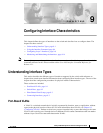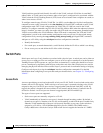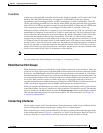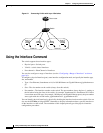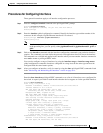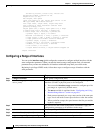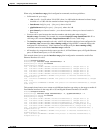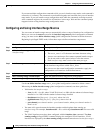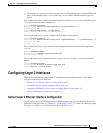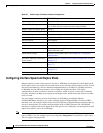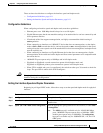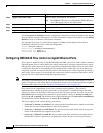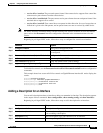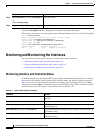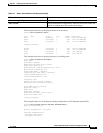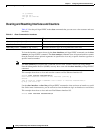
9-9
Catalyst 2950 Desktop Switch Software Configuration Guide
78-11380-05
Chapter 9 Configuring Interface Characteristics
Configuring Layer 2 Interfaces
• All interfaces in a range must be the same type; that is, all Fast Ethernet ports, all Gigabit Ethernet
ports, all EtherChannel ports, or all VLANs, but you can combine multiple interface types in a
macro.
This example shows how to define an interface-range macro named enet_list to select Fast Ethernet ports
1 to 4 and to verify the macro configuration:
Switch# configure terminal
Switch(config)# define interface-range enet_list fastethernet0/1 - 4
Switch(config)# end
Switch# show running-config | include define
define interface-range enet_list FastEthernet0/1 - 4
This example shows how to create a multiple-interface macro named macro1:
Switch# configure terminal
Switch(config)# define interface-range macro1 gigabitethernet0/1 - 2, fastethernet0/5 - 7
Switch(config)# end
Switch#
This example shows how to enter interface range configuration mode for the interface-range macro
enet_list:
Switch# configure terminal
Switch(config)# interface range macro enet_list
Switch(config-if-range)#
This example shows how to delete the interface-range macro enet_list and to verify that it has been
deleted.
Switch# configure terminal
Switch(config)# no define interface-range enet_list
Switch# show run | include define
Configuring Layer 2 Interfaces
These sections describe the default interface configuration and the optional features that you can
configure on most physical interfaces:
• Default Layer 2 Ethernet Interface Configuration, page 9-9
• Configuring Interface Speed and Duplex Mode, page 9-10
• Configuring IEEE 802.3X Flow Control on Gigabit Ethernet Ports, page 9-12
• Adding a Description for an Interface, page 9-13
Default Layer 2 Ethernet Interface Configuration
Table 9-1 shows the Layer 2 Ethernet interface default configuration. For more details on the VLAN
parameters listed in the table, see Chapter 13, “Configuring VLANs.” For details on controlling traffic
to the port, see Chapter 17, “Configuring Port-Based Traffic Control.”



